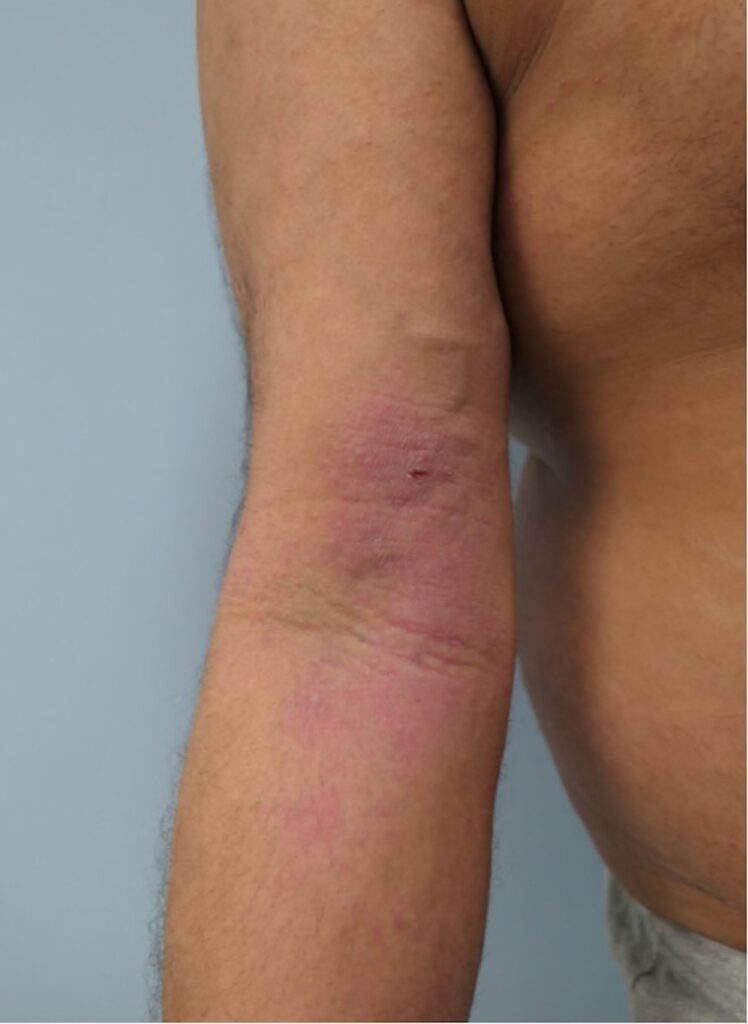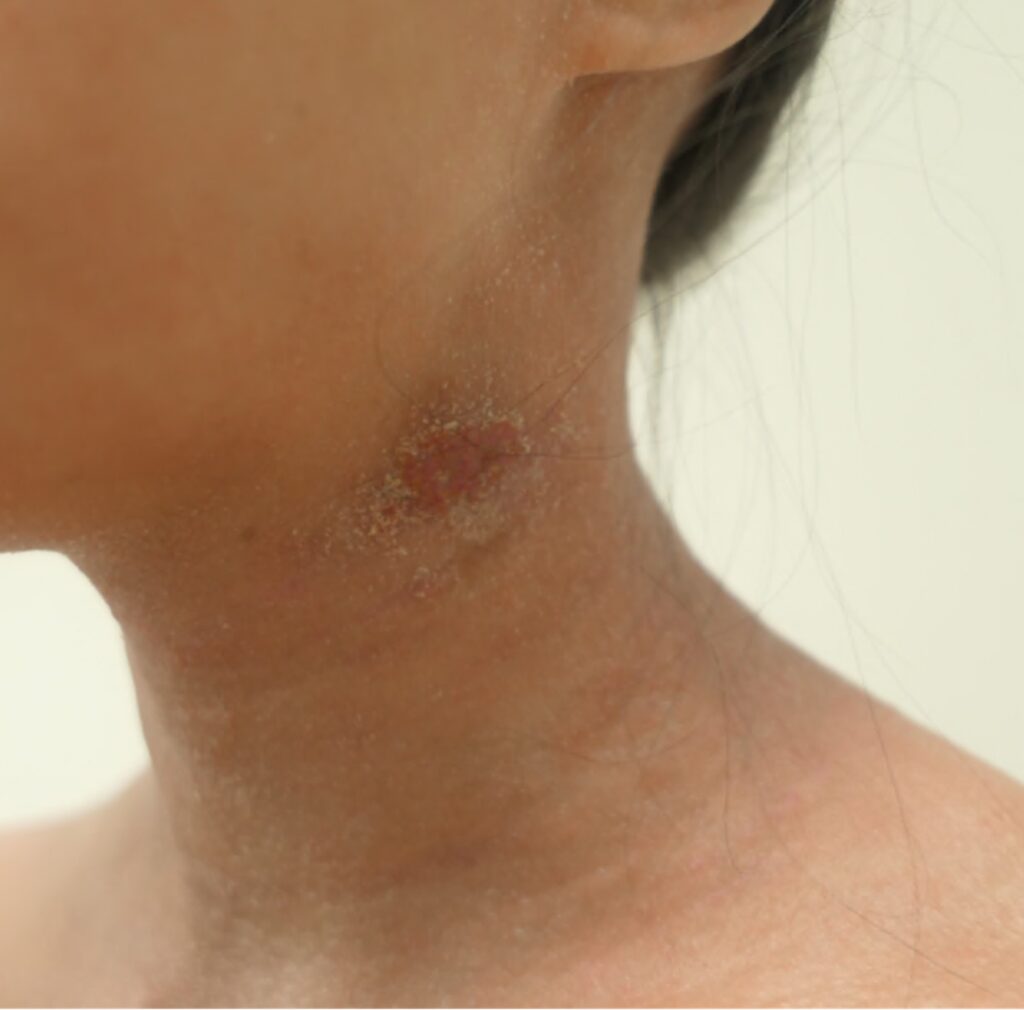Monoclonal antibodies, JAK inhibitors, topical therapies and even microbiome interventions are being explored for the disease.
Atopic dermatitis is a complex skin disease that often presents in general practice.1 Atopic dermatitis is also managed by immunologists, paediatricians, emergency doctors, nurses and pharmacists.2
New to the management of the condition are therapies available through dermatologists, including dupilumab and upadacitinib.3
There are multiple up-and-coming treatments for moderate-to-severe atopic dermatitis: monoclonal antibodies including dupilumab targeting interleukins IL-4 and IL-13 in the pathophysiology of eczema, and JAK inhibitors including upadacitinib, abrocitinib and baricitinib.3-5 Clinical trials are also investigating further biologic therapies and topical therapies. Changing the microbiome is also a potential area of treatment.6
What to look for
Atopic dermatitis can be confusing to identify on examination because it can vary in appearance in its acute and chronic phases, varying according to the patient’s age and ethnicity. Acute atopic dermatitis is seen with pruritus and an evolving erythematous rash that can have oedema, papulation and even blistering present.
Chronic eczema mainly shows secondary features from chronic rubbing and scratching due to the itch. These features may include lichenification, hyperpigmentation and excoriations. Skin dryness (ichthyosis) can also be present.7
Atopic dermatitis begins on the face in infancy, spreading to the thinner flexural areas in childhood and often to the hands in adults. In Asian patients it may be more nodular.8
Differential diagnoses of atopic dermatitis include seborrheic dermatitis, contact dermatitis, pompholyx, venous eczema, asteatotic eczema, ichthyosis, psoriasis, scabies, fungal infection, tinea incognito, strongyloidiasis, lichen planus, lichen sclerosis, bullous pemphigoid, dermatitis herpetiformis and cutaneous T cell lymphoma.9
Red flags
Tertiary referral is suggested for severe uncontrolled atopic dermatitis; secondary skin infections such as eczema herpeticum; sepsis; erythroderma; or patients with suicidal ideation.9 Ocular involvement with severe corneal infection may require enucleation.10-12
Diagnosis
History
The onset, duration and associated symptoms such as pruritus and sleep disturbance need to be assessed in patients presenting with possible atopic dermatitis.13 Triggers can include dust, pollen, pet dander, stress, weather and exercise.14
Patients may also have a history of hay fever and/or asthma, as well as a family history of atopy.14
It is important to ask about what treatments have been trialled in the past, as well as whether they have seen any previous specialists or received any hospital care.15 A history of days off work or school due to eczema will give an indication of the severity of symptoms.15
In addition, eczema patients require an assessment of their mental health.16 Questionnaires such as Patient Orientated Evidence that Matters (POEM) and Dermatology Life Quality Index (DLQI) can be used to assess the psychological impact of the condition and generate discussion about such issues.9
Finally, patients need to be asked about current treatments, including the frequency of use, the strengths of therapeutic formulations and compliance, without forgetting to check their cleansing and moisturising routine.14
Examination
A full body examination should be performed to assess the severity.
Dermatologists use validated scoring systems to assess severity, such as the Eczema Area Severity Index (EASI).17 EASI uses a score of 0-3 to assess the severity of erythema, oedema/papulation, excoriation and lichenification. Investigator Global Assessment (IGA) scores are also used (0-4, with 4 being very severe).

Assessing for secondary skin infections (viral, bacterial, fungal) is important. Blistering within the rash may suggest herpes simplex or eczema herpeticum.18 Bacterial infections can present with impetigo and pustules.18 Fungal infections caused by dermatophytes and yeasts can present with pruritus, erythema, discoloured fingernails and toenails.

Photography can be useful to monitor the severity and progression of atopic dermatitis.13 It is worthwhile to have the patient keep a folder of their photos on their phone as flares don’t always occur in the GP clinic.
Treatment
Education of patients and parents is essential to the successful management of atopic dermatitis. In addition to helping patients identify and avoid triggers of atopic dermatitis, it will also help encourage compliance with baseline topical therapies.
Patients with atopic dermatitis can be given an eczema management plan that will help them manage both daily maintenance as well as more intensive treatment when flares occur.1
Maintenance baseline therapy for atopic dermatitis is to moisturise liberally twice daily.19 Moisturising should ideally be performed after daily soaking in a bath with no irritants, allergens or harsh cleansers. The bath water should be a comfortable temperature and the body needs to be immersed for at least 10 minutes.20 Bathing is more effective than showering as the water can diffuse into the dehydrated skin.20
The skin should be patted dry with a soft towel (not rubbed) and an emollient applied, to trap the moisture within the skin. Ideally, the emollient would contain ceramides, which are the barrier components reduced in atopic dermatitis. Other emollients replacing barrier components sometimes contain natural antipruritic anti-inflammatory agents and may be of benefit, such as I-modulia in the Avène range21 and proteobacteria in la Roche Posay products.22
Prescription medications may be applied on top of the emollient as they are lipid soluble and diffuse into hydrated skin. If steroids and the medicated creams and ointments are applied directly to atopic dermatitis skin with a defective barrier, a greater concentration of the medication will be absorbed into the bloodstream and dermis, causing increased risk of atrophy.
Topical calcineurin inhibitors produce a burning sensation if applied directly onto unprotected skin. However, if such topical medications are applied over emollients, they have a depot effect in the epidermis where they are most needed.
When acute exacerbations of atopic dermatitis occur, maintenance baseline therapy must be continued with the addition of topical corticosteroids on top of moisturiser. Patients need to be educated on the appropriate use of topical corticosteroids, as “corticophobia” commonly sees underuse of this treatment and therefore inadequate response.23
For the body, a potent corticosteroid such as mometasone furoate 0.1% cream can be used. For the face and intertriginous areas, a weaker topical corticosteroid such as hydrocortisone acetate 0.1% cream is recommended. An alternative to topical corticosteroids is topical calcineurin inhibitors such as pimecrolimus and tacrolimus. These are also to be applied on top of a bland moisturiser twice a day.24 Tacrolimus requires compounding in Australia.14
Occlusion with steroids can be used for moderate atopic dermatitis; for example, applying moisturiser and then a moderate topical corticosteroid followed with wet dressings. This therapy is best used in a pulsed fashion, with two weeks on and then two weeks off.9
Flare symptoms may be helped by diluted bleach baths.25
The pruritis associated with atopic dermatitis may be relieved by a daily antihistamine.7,26 Oral sodium cromoglycate (compounded) 100mg daily for adults and 20mg daily for children is often helpful and non-sedating.
Oral antibiotics may be prescribed for a severe acute flare if there is an infection present. If infections are recurrent it may be worthwhile checking the patient (and perhaps family members in the case of a child) for staphylococcus carriage by swabbing the affected areas, nares, axillae and groin.9
Sun exposure can improve atopic dermatitis and UVB therapy may be prescribed by a dermatologist.27
Oral corticosteroids might be considered in severe acute flares although frequent or long-term use is best avoided, especially in children, because of the known side effects associated with long-term use.
Patients whose atopic eczema is severe enough to warrant oral corticosteroids can be referred to a dermatologist for consideration of PBS-funded treatment with subcutaneous dupilumab or oral upadacitinib.3 To be eligible for these biologics through a dermatologist or immunologist, patients need to be 12 years of age or older, have had severe atopic dermatitis affecting either the face, hands or whole body for six months, an EASI of 20 and above, or greater than 30% face/hand coverage despite 28 days of medium-to-high potency topical corticosteroids.28,29
Medications such as methotrexate, cyclosporin, azathioprine and acitretin are also recognised treatments for severe atopic dermatitis. These medications were the primary systemic medications used for atopic dermatitis before dupilumab and upadacitinib were approved for this condition. The medications require patients to be compliant with safety monitoring bloods and contraception.30
Follow up
Follow-up is important to assess the effectiveness of treatment and allow adjustment to the therapeutic regimen if necessary. It also enables the treating clinician to positively reinforce appropriate management techniques, as well as to reassure and re-educate patients and parents. A poor response to treatment should prompt the clinician to revisit the diagnosis; for example, considering allergic contact dermatitis or tinea incognito.9 Or to revisit the prescribed therapy; for example, it might be necessary to prescribe a stronger topical corticosteroid.27
Monitoring for side effects of treatments is also important. For example, methotrexate requires regular checks of renal and liver function, as well on-going reinforcement of the need for contraception.10 The newer biologic treatments for eczema also require regular patient follow-up. Patients on dupilumab require monitoring for side effects such as conjunctivitis, injection-site reactions, facial erythema, upper respiratory tract infections, herpes virus infection and nasopharyngitis3.31-32 Upadacitinib can cause a vulnerability to upper respiratory tract infection symptoms, acne and a worsening of atopic dermatitis.3
- Definition:
Atopic dermatitis is a common and chronic inflammatory skin disease caused by epidermal barrier dysfunction, immune dysregulation, genetic risk factors, lifestyle and environmental exposure.33
- Demographics
In Western countries, children (20%) are more likely to be affected than adults (3%).33-34
Conclusion
Atopic dermatitis is a common, inflammatory skin condition usually best managed by a GP especially when mild or moderate in severity. It is important to identify patients with poorly controlled atopic dermatitis as it can negatively affect a patient’s mental health and ability to attend school or work. New treatment options now exist for patients with atopic dermatitis that appears resistant to standard treatment. To access these treatments patients will need a referral to a dermatologist.
Dr Anna Wilson is a clinical research fellow at Premier Specialists; dermatology unaccredited registrar at St George Hospital, and conjoint associate lecturer at the University of New South Wales.
Prof Dedee Murrell is a dermatologist, head of department and senior staff specialist at St George Hospital, a conjoint professor at UNSW, professorial fellow at The George Institute for Global Health Sydney and director of Premier Specialists, Kogarah.
Dr Anna Wilson is a sub-investigator and Prof Dedee Murrell is an investigator in dermatology clinical trials.
Prof Murrell is the director of Premier Specialists Dermatology Trial Centre. Prof Murrell is also adviser and investigator for Pierre Fabre/Avène, La Roche Posay, Sanofi, Pfizer, Propaira and Ego.
References:
1. Croce EA, Lopes FCPS, Ruth J, Silverberg JI. Interventions to improve primary care provider management of atopic dermatitis: A systematic review. Pediatric Dermatology. 2021;38(5):1004-11.
2. Cheong JYV, Hie SL, Koh EW, de Souza NNA, Koh MJ. Impact of pharmacists’ counseling on caregiver’s knowledge in the management of pediatric atopic dermatitis. Pediatr Dermatol. 2019;36(1):105-9.
3. Siegels D, Heratizadeh A, Abraham S, Binnmyr J, Brockow K, Irvine AD, et al. Systemic treatments in the management of atopic dermatitis: A systematic review and meta-analysis. Allergy. 2021;76(4):1053-76.
4. Silverberg JI, Simpson EL, Boguniewicz M, De Bruin-Weller MS, Foley P, Kataoka Y, et al. Dupilumab Provides Rapid and Sustained Clinically Meaningful Responses in Adults with Moderate-to-severe Atopic Dermatitis. Acta dermato-venereologica. 2021;101(11):adv00585.
5. Sahni VN, Balogh EA, Strowd LC, Feldman SR. The evolving atopic dermatitis management landscape. Expert Opinion on Pharmacotherapy. 2021:1-10.
6. Li H, Zhang Z, Zhang H, Guo Y, Yao Z. Update on the Pathogenesis and Therapy of Atopic Dermatitis. Clinical Reviews in Allergy and Immunology. 2021;61(3):324-38.
7. Howe W. Treatment of atopic dermatitis (eczema). UpToDate. Waltham, MA2021.
8. Kulthanan K, Tuchinda P, Nitiyarom R, Chunharas A, Chantaphakul H, Aunhachoke K, et al. Clinical practice guidelines for the diagnosis and management of atopic dermatitis. Asian Pacific journal of allergy and immunology. 2021;39(3):145-55.
9. Narla S, Silverberg JI. Management of atopic dermatitis in the inpatient setting. Current Dermatology Reports. 2021;10(3):77-88.
10. Sawangjit R, Dilokthornsakul P, Lloyd-Lavery A, Lai NM, Dellavalle R, Chaiyakunapruk N. Systemic treatments for eczema: a network meta-analysis. Cochrane Database Syst Rev. 2020;9(9):CD013206-CD.
11. Cheng J, Jiang L, Morrow NC, Avdic A, Fairley JA, Ling JJ, et al. Recognition of atopic keratoconjunctivitis during treatment with dupilumab for atopic dermatitis. Journal of the American Academy of Dermatology. 2021;85(1):265-7.
12. Villegas BV, Benitez-Del-castillo JM. Current knowledge in allergic conjunctivitis. Turkish Journal of Ophthalmology. 2021;51(1):45-54.
13. Chiricozzi A, Talamonti M, De Simone C, Galluzzo M, Gori N, Fabbrocini G, et al. Management of patients with atopic dermatitis undergoing systemic therapy during COVID-19 pandemic in Italy: Data from the DA-COVID-19 registry. Allergy Eur J Allergy Clin Immunol. 2021;76(6):1813-24.
14. Fleming P, Yang YB, Lynde C, O’Neill B, Lee KO. Diagnosis and Management of Atopic Dermatitis for Primary Care Providers. J Am Board Fam Med. 2020;33(4):626-35.
15. Leong K, Ong TWY, Foong YW, Wong YP, Lim W, Liew HM, et al. Multidisciplinary management of chronic atopic dermatitis in children and adolescents: a prospective pilot study. J Dermatolog Treat. 2020:1-7.
16. Kelly KA, Balogh EA, Kaplan SG, Feldman SR. Skin disease in children: Effects on quality of life, stigmatization, bullying, and suicide risk in pediatric acne, atopic dermatitis, and psoriasis patients. Children. 2021;8(11).
17. Hanifin JM, Thurston M, Omoto M, Cherill R, Tofte SJ, Graeber M. The eczema area and severity index (EASI): assessment of reliability in atopic dermatitis. EASI Evaluator Group. Exp Dermatol. 2001;10(1):11-8.
18. Aoki V, Lorenzini D, Orfali RL, Zaniboni MC, Oliveira ZNP, Rivitti-Machado MC, et al. Consensus on the therapeutic management of atopic dermatitis – Brazilian Society of Dermatology. An Bras Dermatol. 2019;94(2 Suppl 1):67-75.
19. Nicol NH, Rippke F, Weber TM, Hebert AA. Daily Moisturization for Atopic Dermatitis: Importance, Recommendations, and Moisturizer Choices. Journal for Nurse Practitioners. 2021;17(8):920-5.
20. Hua T, Yousaf M, Gwillim E, Yew YW, Lee B, Hua K, et al. Does daily bathing or showering worsen atopic dermatitis severity? A systematic review and meta-analysis. Archives of Dermatological Research. 2021;313(9):729-35.
21. Nguyen T, Chol B, Maitre M, Ravard-Helffer K, Farinole F, Lestienne F, et al. Additional pharmacological activity of I-modulia and generation of two newly designed extracts of Aquaphilus dolomiae culture for dermocosmetic actives. Journal of the European Academy of Dermatology and Venereology. 2020;34(S5):27-9.
22. Gueniche A, Knaudt B, Schuck E, Volz T, Bastien P, Martin R, et al. Effects of nonpathogenic gram-negative bacterium Vitreoscilla filiformis lysate on atopic dermatitis: a prospective, randomized, double-blind, placebo-controlled clinical study. British Journal of Dermatology. 2008;159(6):1357-63.
23. Koster ES, Philbert D, Zheng X, Moradi N, de Vries TW, Bouvy ML. Reducing corticosteroid phobia in pharmacy staff and parents of children with atopic dermatitis. International Journal of Clinical Pharmacy. 2021;43(5):1237-44.
24. Salava A, Perälä M, Pelkonen A, Mäkelä M, Remitz A. Safety of tacrolimus 0.03% and 0.1% ointments in young children with atopic dermatitis: a 36-month follow-up study. Clinical and Experimental Dermatology.n/a(n/a).
25. Chopra R, Vakharia PP, Sacotte R, Silverberg JI. Efficacy of bleach baths in reducing severity of atopic dermatitis: A systematic review and meta-analysis. Ann Allergy Asthma Immunol. 2017;119(5):435-40.
26. Lee JH, Kim JE, Park GH, Bae JM, Byun JY, Shin MK, et al. Consensus update for systemic treatment of atopic dermatitis. Annals of Dermatology. 2021;33(6):497-514.
27. Napolitano M, Monfrecola G, Fabbrocini G, Fattore D, Patrì A, Patruno C. Impact of sun exposure on adult patients affected by atopic dermatitis. Italian Journal of Dermatology and Venereology. 2021;156(2):558-61.
28. Department of Health. Upadacitinib. In: Department of Health, editor. Canberra: The Pharmaceutical Benefits Scheme; 2022.
29. Department of Health. Dupilumab. In: Department of Health, editor. Canberra: The Pharmaceutical Benefits Scheme; 2022.
30. Rajagopalan M, De A, Godse K, Krupa Shankar DS, Zawar V, Sharma N, et al. Guidelines on Management of Atopic Dermatitis in India: An Evidence-Based Review and an Expert Consensus. Indian J Dermatol. 2019;64(3):166-81.
31. Lee H, Kim BR, Kim KH, Lee DH, Na JI. One-Year Effectiveness and Safety of Dupilumab Treatment for Moderate-to-Severe Atopic Dermatitis in Korean Patients: A Real-World Retrospective Analysis. Allergy Asthma Immunol Res. 2022;14(1):117-22.
32. Su Küçük Ö, Güne? B, Talidere N, Iik BG, Akaslan TÇ, Özgen FP, et al. Evaluation of adult patients with atopic dermatitis treated with dupilumab: A single-center real-life experience. Journal of Cosmetic Dermatology.n/a(n/a).
33. Calzavara-Pinton P, Belloni Fortina A, Bonamonte D, Marseglia GL, Miraglia Del Giudice M, Musarra A, et al. Diagnosis and management of moderate to severe atopic dermatitis in adolescents. A Consensus by the Italian Society of Dermatology and Venereology (SIDeMaST), the Italian Association of Hospital Dermatologists and Public Health (ADOI), the Italian Association of Hospital and Territorial Allergists and Immunologists (AAIITO), the Italian Society of Allergy, Asthma and Clinical Immunology (SIAAIC), the Italian Society of Pediatric Allergy and Immunology (SIAIP), the Italian Society of Allergological, Occupational and Environmental Dermatology (SIDAPA), and the Italian Society of Pediatric Dermatology (SIDerP). Ital J Dermatol Venerol. 2021;156(2):184-97.
34. Chidwick K, Busingye D, Pollack A, Osman R, Yoo J, Blogg S, et al. Prevalence, incidence and management of atopic dermatitis in Australian general practice using routinely collected data from MedicineInsight. Australasian Journal of Dermatology. 2020;61(3):e319-e27.



